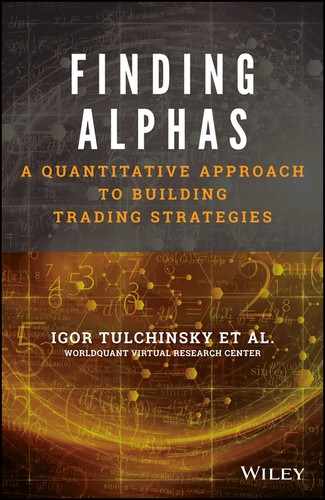5
How to Develop an Alpha. I: Logic with an Example
By Pankaj Bakliwal
Alphas are mathematical models to predict the future price movements of various financial instruments.
Alpha Logic →Information in the Form of Data → Idea → Mathematical Expression → Apply Operations → Final Robust Alpha → Translate into Positions in Financial Instrument → Check Historical PnL, Other Performance Measurements (Information Ratio, Turnover, Drawdowns, etc.)
The goal is to make profits while minimizing risk, and to develop a mathematical predictive formula by using appropriate information. In order to convert this mathematical formula into stock positions, this formula should have three types of values:
Positive → long position
Negative → Short position
0 → No position
Also, the magnitude of the value derived for each stock from the mathematical formula should be proportional to the dollar amount of the position.
Let’s use an example.
STEP 1 → COLLECT INFORMATION
Consider two stocks from the technology sector: Google and Apple. The information is available in the form of daily historical prices of these two stocks. Let’s say that we also have information about an upcoming event that would affect the technology companies either in a positive or a negative manner. The second statement has no directional information.
STEP 2 → COME UP WITH AN IDEA
Once we have all the information available, the next step is to come up with a sensible idea. Let’s say that based on the historical prices, the observation is that the two stocks have trended upwards during the last week. Logic says that in the absence of any additional information, when stock prices rise, profit booking would take place as investors close their long positions, which in turn pushes the stock prices downward. At the same time, when stock prices fall, investors see an opportunity to buy stocks at a cheaper rate, which in turn pushes the stock prices upwards.
STEP 3 → TRANSLATE INTO A MATHEMATICAL EXPRESSION
Converting a thought into a mathematical formula is not always straightforward. In the above case, though, it can be done as follows:
The negative sign indicates that a short position is taken when the trend is upward, and a long position when the trend is downward.
The dollar amount of long/short position in a particular financial instrument is determined by the magnitude of the formula. This means that the stronger the price trend, the more chances the price will be reverting back.
Let’s say the alpha values derived from Eqn (1) for Google and Apple are +2.5 and +7.5, respectively.
STEP 4 → TRANSFORM THE RAW EXPRESSION BY APPLYING OPERATIONS
The raw alpha expression has been developed. The question is: can we make it more robust, more stable? Note that we have one more piece of information – it says there is an upcoming event that would affect the technology companies either in a positive or a negative manner. Can we use this information to make our alpha more profitable?
If our alpha indicates that we should take a long position in both stocks, and the event turns out to be a bad one for the technology sector, thus leading to both the stocks going down drastically, we would end up taking huge losses.
One way to avoid such losses would be to develop a sector-neutral strategy. Such a strategy would not have much downside risk, irrespective of the type of event that is going to occur. A sector-neutral strategy does not have any position in the sector as a whole; i.e. the sum of the positions of the individual stock in the sector is 0. In our example, this would translate to having equal dollar amounts allocated to both the stocks, but in the opposite direction. That is, one would go long one stock and short the other one.
STEP 5 → FINAL ROBUST ALPHA
The final alpha would be a combination derived from both pieces of information. This would change the old values of +2.5 and +7.5 to –5.0 and +5.0 for Google and Apple, respectively.
STEP 6 → TRANSLATE INTO POSITIONS IN A FINANCIAL INSTRUMENT
In order to get the final positions, we can simply apply the following formula:
Final_alpha_stock = (alpha_stock/sum_of_alphas_of_all_stocks) * booksize
So, if we have $10M, we’ll go long $5M on Apple and short $5M on Google.
STEP 7 → CHECK FOR ROBUSTNESS
These are indicators for robustness:
- High in-sample information ratio (IR)
- Good out-of-sample IR
- Works well across the trading universe
- Less fitting
- Intuitive/interesting/simple idea
- Works in multiple regions
- Small drawdowns
- Short drawdown periods
